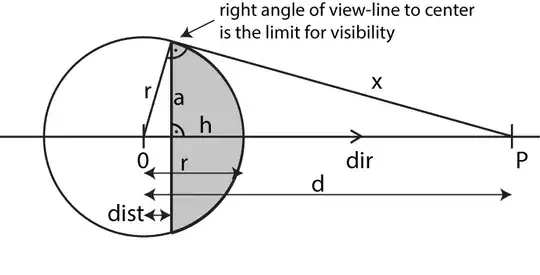For a sphere of radius $r$ and a point at a distance $d$ from the center of the sphere you can directly "see" a spherical cap. The cap is limited by the circle that is given, where the ray from $P$ to the point on the sphere has a right angle from that point to the center of the sphere. All points with a larger angle than 90° is visible, all with smaller angle is not visible. The limit is a circle at exactle 90°. Let's derive the parameters for that spherical cap, first the radius of the limit circle $a$, and the height of the cap $h$.
Here is a sketch for the derivation:

$x^2 = d^2 - r^2$
$\frac{a}{x}=\frac{r}{d}$
therefore:
$a=\frac{r}{d} \sqrt{d^2-r^2}$
From the relation
$r^2 = (r-h)^2 + a^2$
we can derive the cap height $h$ and therefore the distance from the center $r-h$:
$h = r - \sqrt{r^2 - a^2}$
$\mathit{dist} = r - h = \sqrt{r^2 - a^2}$
The direction of the center of the cap is the same as the direction from the center of the sphere to the point $P$.
The only missing point is to derive the coordinates of the circle of this cap. I assume the sphere is centered in the origin of the coordinate system. The limit circle would be given as a tilted 3D circle with the following parameters:
$dir = \frac{P}{|P|}$ (axis of 3D circle)
$center = dir * dist$
$radius = a$
You can compute the points of the circle in cartesian coordinates as described here: https://math.stackexchange.com/a/73242/264838
You can convert these points to spherical coordinates as outlined here: https://en.wikipedia.org/wiki/Spherical_coordinate_system#Cartesian_coordinates
If you only want to test a point $B$ on the sphere whether it is visible from $P$, just test for an angle >90°. You can experiment with the relationships in this Geogebra sheet: http://tube.geogebra.org/m/1564793
$\cos{\alpha} = \frac{(O - B)\cdot(P - B)}{|O - B| |P - B|}$
since $\cos{\alpha} = 0$ we just need to test
$0 > (O - B)\cdot(P - B)$
where $\cdot$ is the dot product, and $O$ is the center of the sphere, or $0$ if it is in the origin.


 – Sam Baker
Sep 04 '15 at 20:52
– Sam Baker
Sep 04 '15 at 20:52